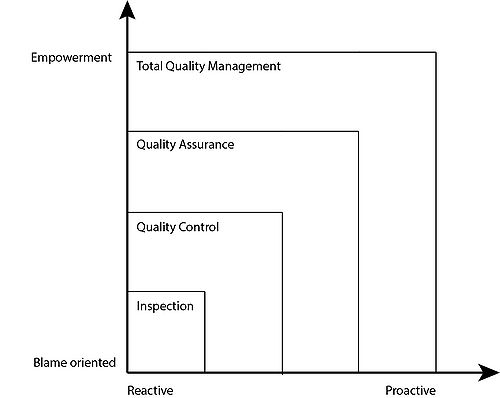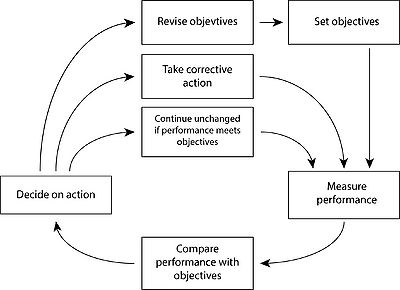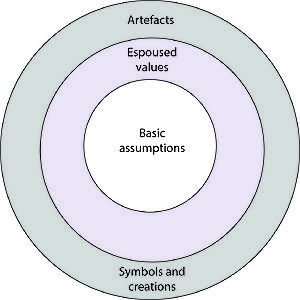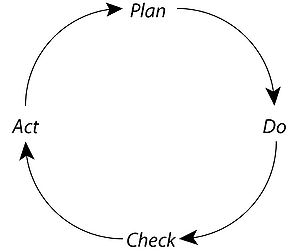Total Quality Management
Total Quality Management (TQM) is a Quality Management System (QMS) and a management approach where an organisation strives to provide customers with product and services of a high quality and a continuous improvement of the means to do so. TQM requires an establishment of a culture of improvement where quality is top priority in the whole organisation; from floor to top management. TQM should be applied as a programme for cultural change. The culture needs quality in all aspects of the organisation’s operations and seeks to integrate all organisational functions focusing on compliance with customer needs. The focus is proactive; processes and productions is being done right initially in order to eliminate defects and waste.
Total Quality Management was popular in the late 1980s and early 1990s, but the use of TQM is not too widespread today due to competition from other quality management systems such as Lean Manufacturing, Six Sigma and the ISO 9000 series. [1]
Contents |
Quality Management Systems [2] [3]
The main goal in business is to focus on the profit and savings, and also on the additional revenue that a company can achieve. The way to reach this objective is found by eliminating errors throughout the operations, production of products and services at the level of quality desired by customers. Errors can increase amount of costs significantly. To avoid errors the Quality Management Systems (QMS) are used. The purpose of QMS is to secure quality of product and manage the communication between management and employees; telling them what is required to produce and what desired quality level to be achieved of specified products and services.
QMS consists of four main systems:
- Inspection, where work is physically checked in order to secure that is has been completed satisfactorily.
- Quality Control (QC), where management control techniques is used in order to achieve fulfilment of quality requirements.
- Quality Assurance (QA), where externally accredited procedures and techniques are used in order to ensure that quality management practices are carefully followed.
- Total Quality Management (TQM), where the organization is motivated to do continuous process improvements to achieve increasingly higher levels of quality.
The four different systems all vary in the degree of responsibility given from management to employees, also called empowerment, and in the degree of proactiveness, starting with completely reactive to being proactive (see figure: Quality Management Systems). The systems are getting increasingly more elaborated from Inspection to TQM.
These four systems will be further explained in the following sections.
Inspection
Inspection is "conformity evaluation by observation and judgement together with measurements and testing". It is the lowest degree of Quality Management. Usually inspection is executed by a third part who did not participate in the production of the object. The object is either accepted or rejected; following rejection goes either reworking or scrapping of the product, were additional costs follows. Furthermore, there are two more disadvantages of inspection. Firstly, dedication of ressource are required to the inspection progress. Secondly, the way of saving expenses and ressources with performing sampling method reduces the effectiveness of inspection itself. But inspection procedures are still vital for assurance of the product's quality and conformance with customer specifications.
Quality Control
Quality control is focused on fulfilling quality requirements. There are numerous of operation techniques available, but often reference is made to Ishikawa’s seven QC tools, which follows:
- Cause-and-effect-diagrams (also known as fishbone chart), where possible causes for effects or problems are identified.
- Check sheet, which is a structured, planned and prepared sheet for collecting and analyzing data. It is a general tool that can be used for several purposes.
- Control charts, which are graphs that show the development of one or more processes over time.
- Histogram, a tool for showing frequency distribution or how frequently a specific error or defect occurs.
- Pareto chart, is used to show which factors are most influential. Shown on a bar chart.
- Scatter diagram, a use of pairs of numerical data where a relationship between the pair is suspected. The data is input in a graph.
- Stratification, a separation of data from different sources, so patterns can be detected with more ease. E.g. data from different production facilities. [4]
Quality Assurance
Quality Assurance is focused on providing confidence that quality requirements will be fulfilled. The aim of QA is to provide an overall set of procedures for the management of quality. QA specifies when and where inspections should take place using which criteria; and which QC tools should be used when. The QA system are not made to identify conformance or non-conformance by itself, but it simply provides the specifications for procedures of identification. There are three basic types of QA systems:
- First-party systems, where the organisation itself assures that it meets certain requirements.
- Second-party systems, where an association to which the organisation belongs provides the assurance.
- Third-party systems, where QA system is certified by an independent third party.
Best practice are third-party certification-based systems and these usually corresponds to the internatiol standards particularly the ISO 9000 series. The standards specify what a QA system should contain. Therefore, a client can feel confident that the company has the ressources and skills to implement processes that ensure client satisfactory service according to agreed quality standards.
Total Quality Management
Inspection, QC and QA all have two important limitations:
- They are first-order information loops (see figure: The Generic Information Loop) around static standards. Therefore performance is 100% if there are found no defects. But that does not mean, that defects do not exist.
- The systems only focus on operation and do not take, among other factors, customer satisfaction into account.
Thus continuous quality improvement is not a part of inspection, QC and QA.
TQM is focused on the creation of an culture of improvement; a culture where the whole organisation always strives to deliver quality products and improve quality by time. Quality improvement is the part of quality management focused on increasing the ability to fulfill quality requirements. The processes by which these improvements are created are usually called Total Quality Management.
TQM aims to deal with issues with encouraging continous improvement with regards to conformance by improving process capability and ensuring quality standards set for the process are suitable for the end product delivered to the customer. Therefore TQM is more an approach to managing the business than a strict defined set of quality management procedures and tools. As a project manager it is therefore important to create the right project culture and anchor the culture in everyone involved.
Principles of Total Quality Management [2] [3] [5]
Employee Empowerment
“Tell me and I forget, teach me and I may remember, involve me and I learn.” ― Benjamin Franklin
The word power is derived from the latin word potere and means "to be able". Empowerment is defined as follows: "To give power or authority; authorize. To give the ability to enable". Empowerment is about involving the employees by empowering them. Unless indivual employees take personal responsible for operations, the process capability will not be improved. No inspection system is bulletproof. As a rule of thumb it is given, that a organisation which uses 100% inspection will fail to reject 20% of non-conforming components. Sampling techniques are not perfect and therefore an expected part of the non-conforming components will not be detected. These sampling techniques also tend to pass responsibilty from employee to the inspector; who does not have the same experience with the product as the employee producing it. The person who first knows if a component is non-conforming is the employee. Thus it is more effective and cheaper to empower the employee to do own quality controls. However this requires a culture where employees are not blamed for quality problems and do not lose payment due to stoppage of operation if a given issue arise. Empowerment requires trust and the organisation must deal with human ressource issues, because it is a two-way commitment and it is the key to effective quality management.
Training
Training is the skill, knowledge or experience acquired by the one who trains. In order to achieve high conformance, high quality, the skills of the employees are, if not the most important, one of the most important determinants of succes. The less educated and trained the employees are, there less the chance of achieving acceptable levels of process capability. Therefore education and training is key to achieving high quality. Employees also needs to be educated in relevant QC tools and in the given QA system, so they can identify and remove problems related to quality and follow the linked procedures properly. The goal with training is to have a workforce with a high competence level in their respective fields. This is different from qualifications, thus qualifications is a measure of what e.g. titles and papers you have achieved through education, but it does not necessarily describe how well you use this knowledge in practice and thereby does not describe the level of compentency. General skills are a product of education and job specific skills are the result of learning on the job which is reinforced by job-specific training.
Organisational Learning
A culture of improvement extends the single-loop and double-loop in The Generic Information Loop. They are learning how to learn. A culture of improvement aim is zero defects. The improvement of process capability are slow and steady typically achieved through quality circles, using QC tools to track down reasons for non-conformance. Quality circles are teams of employees and line managers working side-by-side to solve conformance problems (i.e. quality problems). It is important that the analysis and identification of problems and solutions to same are being carried out as a team, because this enables team ownership of the solution.
In general there are four levels of organisational learning:
- Individual learning, which is the lowest level of organisational learning. And employees can learn skills or ideas that may result in enchanced process capability, as a result of gained expertise. The employees can either choose to share their newly gained knowledge within the group or keep it to himself. In the case where the employee leaves the group or the company and has not shared this knowledge with the group, the group has lost this knowledge. Therefore knowledge sharing is important in order to advance to the next level of organisational learning
- Group learning, is a process where employees share their knowledge in the group, so everyone belonging to the group benefit from this newly aquired knowledge. It is important that individuals within the group acquire, share and combine their knowledge. This can take place as a formal process (e.g. arranged meetings, knowledge-sharing database) or an informal process (e.g. conversation at lunch, experience with one another).
- Organisational learning, is defined by the way an organisation chooses to create and organize knowledge. The aim is to share relevant knowledge throughout the organisation. Organisational learning should be happening in all of the activities of the organisation in order to prevent silos (silo: a part of an organisation from where knowledge is not shared with the remaining organisation).
- Interorganisational learning, is defined by the way in which different organisations in a collaboration share knowledge and learn from one another. An organisation can improve its process capability by implementation of knowledge gained from another organisation. Instead of learning from own organisation, but learning from other organisations, an organisation will be able to increase process capability without risks associated with problem solving and learn faster. The organisation can either choose to apply the same ideas used by the other organisation or choose to modify the idea; to tailor it to own needs. A good example of interorganisational learning is from franchise businesses, e.g. McDonalds, where knowledge sharing is key to success. The franchisee has to learn how to use and how to implement the organization's business model before starting a franchise. Benchmarking is also an example of when organisations thrive to learn from one another.
Allignment of Incentives with Desired Performance
In order to succesfully empower the employees, incentives have to match desired performance. Often the incentives undermine the strategic goals being set by organisation. E.g. while the goal might be to do product "right the first time", the reward can be based upon volume of output and not quality of output. The incentive framework should always be aligned with the specifications to product given by the client and thereby support conformance.
Management Commitment
It order to create a culture of improvement the involvment and commitment of the management must be present. It is important to communicate the strategies and goals throughout the organisation, and to clarify just how important this is to management. There are three levels of organisational culture a manager can influence:
- Artefacts and creations, these are visible symbols of the culture in the organisation. It can be clothing of employees, layout of offices, architectural expression of headquarter, projects achieved etc.
- Values, this reflects what people say and how they justify decisions. It is the espoused values.
- Basic assumptions, which are the product of education and socialisation. These can also be seen as the taken-for-granted values-in-use, which is basis for decision-making. They may not be explicit and are not neccessarily congruent with the espoused values.
A manager should carefully analyze which level of organisation culture he should influence in order to make the commitment visible and to anchor the culture he strives to create.
Fact Based Decision Making
Fact Based Decision Making (FBDM) means that decisions should be made based on data and analysis and not based on beliefs. This approach should encourage managers on all levels to effectively make decisions based on data, considerations of all options and an analytic prediction of outcomes.
The following tools can be useful for FBDM:
- SPC (Statistical Process Control)
- DOE (Design of Experiments), FMEA (Failure Mode Effects Analysis)
- The 7 Statistical Tool
- Eight Disciplines Problem Solving (Ford 8D), which follows the principles of the PDCA cycle.
Continuous Improvement
TQM aims to continuously improve all work, from strategic planning and decision making to detailed specification and execution of work processes on the floor. The philisophy behind TQM is build on the belief that errors can be avoided and defects be prevented. A contnously improvement of capabilities, people and processes, in all aspect of work, will continuously improve results. The main focus is not to improve results (which of course is desired) but improving the means to do so. It is also important to include suppliers in the TQM programme.
In TQM it is recognized and accepted that mistakes are made by people, but that these mistakes are a result of faulty systems and processes. Thus it is important to identify the root cause of such mistakes, so they can be eliminated and repitition of mistakes can be prevented, simply by changing the process. At Toyota's production line employees on the floor can shut down a part of the production line if mistakes happen. Then management and the given employee(s) will analyse the mistake and take action in order to prevent it from happening in the future.
There are three major mechanisms of prevention:
- If a mistake is found, prevent it from occuring in future.
- If mistakes can not be prevented, it is important to detect them early in order to ensure, that the mistakes are not being passed further.
- If mistakes recur it is important to stop production until process can be corrected to prevent production of any more defects.
The management should make use of the Plan-Do-Check-Act cycle (PDCA cycle), which is an iterative four-step method used in business to control continuous improvement of processes.
Plan
Plan a change. The goal with the plan is to establish objectives, goals and processes which are needed to deliver results in compliance with the target output.
Do
Do the plan. The implementation of the plan. Execute the processes and make either the product or service. Hereafter a collection of data for later analysis is carried out.
Check
Check the results. The results from the earlier data collection (from the Do section) are analyzed and compared against the expected results (from the Plan section) in order to identify any differences. It is important to look for deviations from implementations of plan as well (if the Do step is carried out accordingly to the plan, i.e. the Plan step). Charting (i.e. visualization) of data is important, especially when analysing data from multiple PDCA cycles. This step is basis for decision-making in later steps, therefore the quality of data and presentation of same is important.
Act
Act upon results. If the Check step shows improvement to prior standards due to implementation (Do step) of the plan (Plan step), then these new processes becomes the new standard for how the organisation should act in the future. If the Check step however shows that there were no improvement, there will be no changes in standards and the existing standard will remain. The Actstep is all about taking action based on the analysis done in the Check step. In both cases, improvement or not, if the Check step analysis reveals something different than expected regardless of it is better or worse, the organisation have learning to do. Based on the learning the organisation have to decide upon what to do in future PDCA cycles; adjustments and corrections to plan must be made. And it is important that the decisions made are fact based.
Customer Focus
Costumer focus is the key to achieving quality, as quality is the customers perception of the product, therefore it is a central part of TQM. There are numerous ways of achieving a high level of customer focus, but communication and collaboration are cornerstones.
Application
TQM are designed for manufacturing companies but can be applicated in other business. TQM should be treated as programme, where the whole organisation is involved and every project applies the culture of improvement in order to reduce errors and defects. There is no manual for how to implement TQM, but there is several factors, where success have to be obtained in order to succesfully implement TQM. In the table below the most important succesfactors for implementation of TQM are summarized.
| Category | Critical Succes Factor |
|---|---|
| Leadership | Management commitment, organisational commitment |
| Empowerment | Training, organisational learning, employee satisfaction, education |
| Supplier Management | Supplier quality management, supplier partnerships |
| Process Management | Quality policy, quality improvement systems, operating procedures |
| Quality of Data | Data reporting, proper visualisation of data, quality information systems |
| Customer Satisfaction | Customer focus, customer management |
| Communication | Communication of improvement information, knowledge sharing to improve quality |
Abbreviations
- TQM – Total Quality Management
- QMS – Quality Management Systems
- QA – Quality Assurance
- QC – Quality Control
- PDCA – Plan-Do-Check-Act
- DOE - Design of Experiments
- FBDM – Fact Based Decision Making
- FMEA - Failure Mode Effects Analysis
- SPC - Statistical Process Control
References
- ↑ Wikipedia: Total Quality Management https://en.wikipedia.org/wiki/Total_quality_management
- ↑ 2.0 2.1 Winch, Graham M. (2010), Managing Constructions Projects, 2nd Edition, Chapter 12, p. 316-345.
- ↑ 3.0 3.1 Sanders & Reid (2013), Operations Management: An Integrated Approach, 5th Edition International Student Version,, Chapter 5, p. 136-170.
- ↑ ASQ.COM: The 7 Basic Quality Tools for Process Improvement http://asq.org/learn-about-quality/seven-basic-quality-tools/overview/overview.html
- ↑ Isixsigma.com: Introduction and Implementation of TQM https://www.isixsigma.com/methodology/total-quality-management-tqm/introduction-and-implementation-total-quality-management-tqm/
- ↑ Dr. A. Nkoyock: Practical Applications of Total Quality Management http://nkoyock.net/blog/?p=52
Annotated Bibliography
| Author | Title | Date | Category | Chapter | Pages | Brief description | Link |
|---|---|---|---|---|---|---|---|
| Winch, Graham M. | Managing Constructions Projects | 2010 | Book | Chapter 12 | 316-345 | The book is used in university teaching as an introduction on how to manage construction projects. Chapter 12 describes TQM with a focus on contruction | - |
| Sanders & Reid | Operations Management: An Integrated Approach | 2013 | Book | Chapter 5 | 136-170 | The book provides a solid foundation of Operations Management with clear, guided instruction and a balance between quantitative and qualitative concepts. Chapter 5 is a general introduction to the concept of quality and TQM. It also includes examples of use of TQM with two different cases | - |
| ASQ.COM | The 7 Basic Quality Tools for Process Improvement | 2016 | Homepage | - | - | ASQ is a global community of people managing quality. The link introduces the 7 basics quality tools for process improvement. Each tool can be further investigated by clicking the respective link | http://asq.org/learn-about-quality/seven-basic-quality-tools/overview/overview.html |
| Isixsigma.com | The 7 Basic Quality Tools for Process Improvement | 2016 | Homepage | - | - | Isixsigma.com is a global community of people working with Six Sigma. It includes forums, articles, etc. The link describes how to introduce and implement TQM from a general aspect. | https://www.isixsigma.com/methodology/total-quality-management-tqm/introduction-and-implementation-total-quality-management-tqm/ |
| Dr. A. Nkoyock | Practical Applications of Total Quality Management | 2010 | Homepage | - | - | This homepage is a blog from Dr. A. Nkoyock, which gives another aspect of application of TQM. Dr. Alain Nkoyock earned a Doctorate of Management in Organizational Leadership with a Specialization in Information Systems and Technology from University of Phoenix in Arizona. | http://nkoyock.net/blog/?p=52 |
| Wikipedia | Total Quality Management | 2016 | Homepage | - | - | A short introduction to TQM (as it was in the 1980's) | https://en.wikipedia.org/wiki/Total_quality_management |



